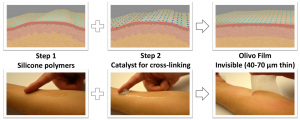Skin is crucial part of our body, and as a part of the body, it ages. As the skin ages, it loses its ability to recover rapidly and gets damaged easily. Many people get stressed as they look in the mirror every morning, about wrinkles and blemish on their faces, and hope that they can erase them. Unfortunately, it is almost impossible to recover the skin to its full youth state with existing solutions.

Image from Pexels : https://www.pexels.com/photo/black-and-white-crinkles-elder-elderly-258308/
To solve these problems, scientists have developed a ‘second skin,’ which is a clear, flexible polymer that mimics the properties of real skin that can be worn directly to the skin.
The idea of artificial skin came with scientists’ interest in creating autonomous intelligent robots among with other applications, leading to development of electronic hand with sensors since 1974. A lot of research has been conducted then to enhance the function of electronic skin and to make it resemble that of human. Inspired from scientific fictions, researchers have developed flexible and active-matrix electronic skin in 2004. However, there was still a long journey left to catch up with the complicated, real skin.
Finally in recent studies, Daniel Anderson, an associate professor in Chemistry Engineering in MIT, and his research team along with Harvard University developed a ‘second skin,’ called XPL. This wearable skin, an elastic polymer layer, has the properties of real skin and can be applied on human skin as a cream, instantly without use of heat or light-mediated activation.

Application of platinum catalyst to polysiloxane compound. Image credit : Olivo Labs
The second skin works in two-step process, where polysiloxane compounds, followed by platinum catalyst, is applied. The platinum catalyst enables the polymer to be attached to the skin for up to 24 hours, resisting washing and rubbing. The platinum catalyst does this by creating a strong layer on top of the polysiloxane compounds and adhering strongly to the skin.
To see the applicability of this material, Anderson has observed the visual impact when it is worn, tested on durability by twisting the skin with XLP on top, by wearing it over 24 hours, and by washing and rubbing under running water. The result was amazing. The ‘second skin’ was found to be ‘wearable, moisturizing, safe, well tolerated, and provides enhanced mechanical integrity to the underlying skin’ (Anderson, 2016).
“So the goal was to really create something that was totally invisible, breathable, could coat the skin, protect it, perhaps deliver drugs to it, and also perhaps even make it look better,” Anderson says.
Not only does it hide the wrinkles which many people get stressed about, it also protects our skin from UV radiation, the well-known main cause of skin cancer.
While further research will be continued to create more ideal products in the future, the ability to deliver drugs, to protect the underneath skin layer, and its invisibility gives hope to the people with diseases or wounds on their skin. Also, this could make our life easier by replacing cosmetics!
-Diana Kim-

One response to “Anyone Wants a Second Skin?”